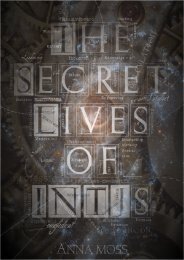You also want an ePaper? Increase the reach of your titles
YUMPU automatically turns print PDFs into web optimized ePapers that Google loves.
will carry books with them everywhere—to the table, to recess, on the bus. They will even read in<br />
class, annoying the teacher (especially if the INTJ is reading the in the textbook and has gotten<br />
several chapters ahead). Many INTJs read books that are beyond their age level; some even learn to<br />
read without being taught. Their continual reading helps them build up a large vocabulary. They<br />
often employ surprisingly complex sentence structures for their age.<br />
Play<br />
Some of the most enjoyable INTJ play takes place completely within the INTJ’s own imagination.<br />
Keirsey (1998) has noted that Sensor children will tend to play with toys in the way they are meant<br />
to be played with, i.e. a toy fish will be played as a fish swimming its way through the deep. For<br />
Intuitives, on the other hand, the toy fish may actually be a submarine in the shape of a fish.<br />
What this means is that any object can transformed in the INTJ’s mind into a plaything to tell<br />
stories about. A dart may become a rocket. A toy lizard may become an alien monster. All the rest<br />
of the scenery can be completely imagined. Lost in their own world, a young INTJ may be just as<br />
unaware of things going on outside as any adult INTJ focusing on a problem. INTJs are also good<br />
at playing inside their heads. An INTJ can play in perfect silence, imagining their toys' sounds and<br />
voices in their heads. Not that all INTJs do this, but it is more common among INs than with other<br />
types. INTJs have rich imaginations and can even create imaginary friends to play with.<br />
Thanks to their logical/strategic abilities, young INTJs are particularly good at simple strategy<br />
games like tic-tac-toe. They will experimenting and memorize the various moves in a precursor to<br />
chess. INTJ children will invent new ways of playing board games with completely new rules and<br />
abilities. They may even combine games together and play across multiple boards or create entirely<br />
new board/card games from scratch. Favorite INTJ board games include Monopoly, chess,<br />
checkers, Risk, Othello, Scrabble, Boggle and Life—basically strategy and word games that rely on<br />
thought more than luck. They also enjoy thinking card games and puzzles. Some of the more<br />
extravagant card-and-dice roleplaying games like Magic: the Gathering also hold attraction for<br />
INTJs.<br />
Legos are an all-time favorite with this type. They also love building materials such as Tinker Toys,<br />
K'Nex, Meccano, Erector sets, blocks, Lincoln Logs, etc. Marble mazes, toy train sets, and car<br />
tracks are also enjoyed for their construction potential. INTJs like to create highly elaborate set<br />
ups; they are able to resist the temptation to knock over dominoes longer than other kids. INTJs are<br />
known for getting bored of toys once they have "figured them out." They crave intellectual<br />
stimulation and may desire toys that are above their age level.<br />
They didn't have Legos back in the 1600s, so a young Isaac Newton was forced to improvise. He<br />
bought himself a book, The Mysteries of Nature and Art, which contained plans for small crafts and<br />
devices. This book was put to good use; it was noted of him that, he had a “strong propensity to<br />
mechanicks which was his first & favourite amusement. Mrs Vincent said he spent most of his time<br />
when out of the school in making knick knacks & models in wood of several kinds, for which<br />
purpose he had got little saws hatchets hammers & a whole shop full compleat sett of tools which<br />
he handled with great dexterity; he would often make little tables & cupboards lanthorns [lanterns]<br />
of crumpled paper & Kites, he was very exact in setting the proportions of the latter & finding out<br />
the proper places where the strings were to be fastened.” His models included a mouse powered<br />
windmill, a lantern, a mousetrap, chimes, a human-powered go-kart, a sundial and numerous other<br />
mechanisms. 225<br />
225 Westfall, 1980




